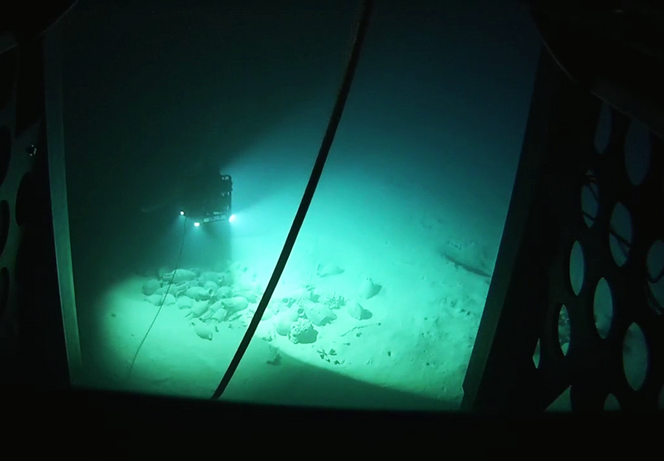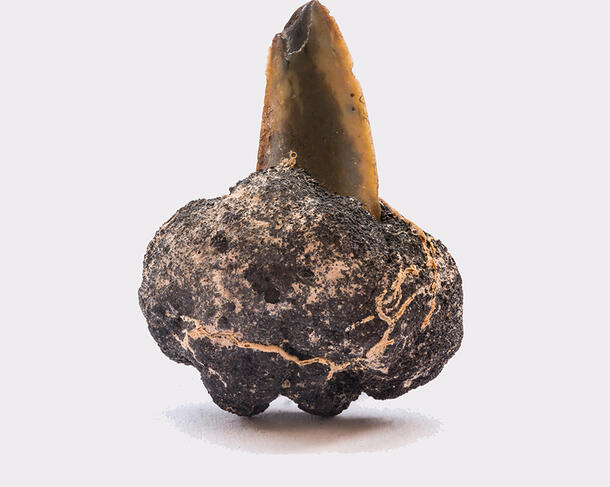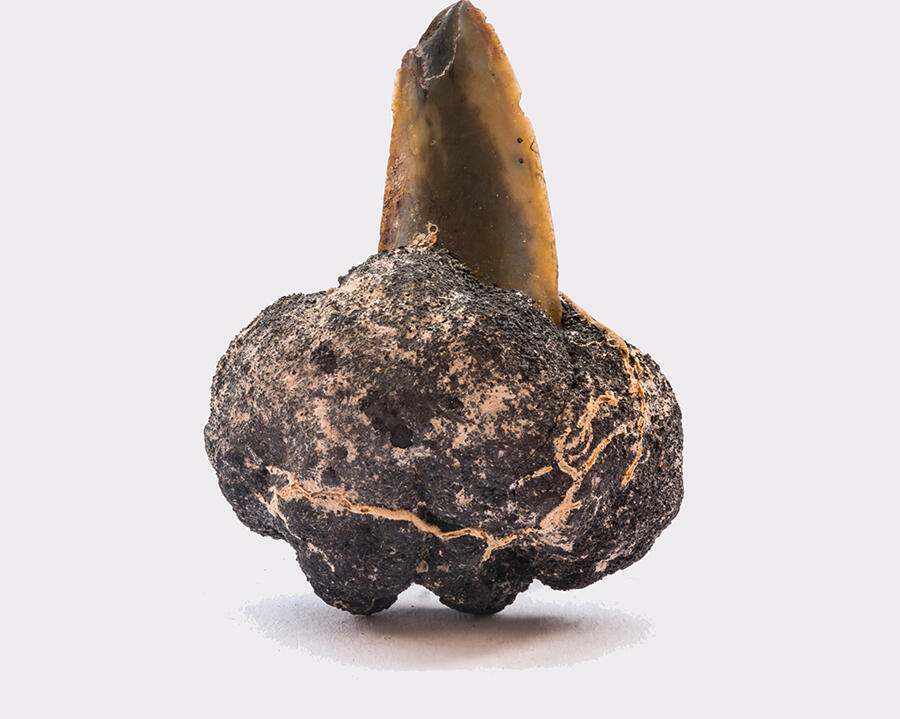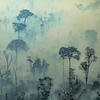You are here
The deep seabed, a little-known world under threat

In October 2022, the MV Hidden Gem completed its first large-scale recovery of minerals from the deep seabed. The Metals Company, which owns the ship, brought up to the surface 4,500 tonnes of polymetallic nodules, metal-rich concretions lying on the seabed at a depth of some 4 kilometres. Following this successful technological achievement, the firm announced that it would start mining on an industrial scale by 2024. It may or may not be bluffing, but in any case, the spotlight is once more being turned onto the deep seabed, which harbours immense treasures.
If the claims of The Metals Company are to be believed, the mining of minerals from the seabed should not be a matter for controversy. To harness renewable energy, they argue, you need batteries, and to make batteries you need cobalt, lithium, manganese, and copper. Their take-home message is simple: there will be no energy transition without underwater mining. However, deep seabed mining could turn into yet another threat to ocean ecosystems, jeopardising some of their functions, such as their role as a carbon pump.
A wealth of raw materials
Three types of ocean deposit are in the sights of mining companies. Firstly, polymetallic nodules, which are rich in cobalt, manganese, nickel and copper. The nodules, which are a few centimetres in diameter, resemble black pebbles lying on the seabed. They are the result of millions of years of accretion: metals dissolved in the water precipitate out and are deposited on the surface of a hard object, such as a shell, a pebble, or a fish tooth, which acts as a nucleus. They form infinitesimally slowly, just a few millimetres per million years, and may be related to the action of certain microorganisms.
Then there are sulfide deposits, which are found around hydrothermal vents, in the vicinity of mid-ocean ridges. The hot, corrosive water from the vents leaches minerals from the rocks of the oceanic crust and becomes loaded with metals and sulfides. When it gushes out from the seabed and comes into contact with cold seawater, the metals precipitate out, forming large deposits of sulfide minerals.
Finally, there are polymetallic crusts. Although they form in much the same way as nodules, the process takes place on the rocky flanks of seamounts. These deposits contain a wide variety of elements, primarily cobalt, and can be as much as several tens of centimetres thick over areas ranging from a few square kilometres to several hundred.
It is currrently impossible to calculate the extent of deep-seabed mineral resources. However, estimates by the United States Geological Survey suggest that the Clarion-Clipperton Zone, a region in the northeastern Pacific the size of the European Union, may contain 21 billion tonnes of nodules. It is thought that this area, which is currently being prospected by The Metals Company, contains more cobalt and nickel than all the world's land-based mines put together. Enough to whet appetites on a par with the gold rush.
“We know more about the surface of the Moon and Mars than we do about the deep seabed,” says Sarah Samadi, a biologist at the ISYEB.1 In fact, only 5% of the deep seabed, defined as that lying at a depth of at least 200 metres, has been mapped. In addition, virtually nothing is known about the organisms living at such depths, which is why one of the greatest fears scientists have about mining operations is that ecosystems will be wiped out before they have even been discovered.
As yet undiscovered ecosystems under threat
“The main vulnerability of deep-sea ecosystems is our lack of knowledge,” Samadi explains. “Only a tiny fraction of their biodiversity has been explored.” When researchers sample species in a deep-sea environment, most of the animals they collect are unknown. “New ones are still being discovered in samples collected 30 or 40 years ago!” the biologist adds.
Under these conditions, it is impossible to assess the risks of mining activity on a specific ecosystem. The problem is that knowing which organisms are present is not enough to understand how an ecosystem works. It is also necessary to define how they adapt to their environment and how they fit into the overall dynamics of the ocean.
“The Earth's hydrosphere, atmosphere, lithosphere, and mantle are all interrelated,” points out Mathilde Cannat, a researcher at the IPGP.2 “You can't do science without taking these interconnections into account.” One example of the way in which these different systems are interwoven is provided by the hydrothermal vents on mid-ocean ridges, which Cannat believes are of utmost importance: “It is there that the interaction between the mantle and the outer layers of the Earth is at a maximum.” The researcher is involved in the design and maintenance of the EMSO-Açores observatory, located on a hydrothermal field called “Lucky Strike” on the Mid-Atlantic ridge. One of the aims of the observatory, which has been up and running for over ten years, is to elucidate how the vent ecosystem works. The researchers are trying to understand how the fauna adapts to this extreme environment, as well as the role played by microorganisms.

The idea that the ocean floor is a vast monotonous expanse where only the most humble forms of life exist is outdated. Although the ocean deeps are devoid of plant life, they harbour a striking variety of ecosystems. “All the phyla of the animal kingdom are represented on the sea floor,” Samadi explains. Some of these ecosystems have captured the imagination of researchers, such as the famous black smokers on the mid-ocean ridges where giant tube worms, clams and white crabs abound. Until they were discovered in the 1970s, no one could have imagined such thriving biological communities in the absence of plants and photosynthesis. This was because no one had taken into account the existence of chemosynthetic bacteria that derive their energy from hydrothermal sources.

However, mid-ocean ridge ecosystems are not the only ones of interest to scientists. For instance, seamounts, which are underwater mountains or volcanoes rising from the ocean floor, are havens of biodiversity. They provide varied supports for many sessile animals animals that live attached to a substrate – Editor's note such as corals, sponges, sea anemones and tube worms, which in turn attract pelagic organisms. On the deep ocean bed, any object that provides a different type of habitat leads to an increase in the number of species present.
A wreck, for example, can form the basis of a deep-water coral reef. A whale carcass will attract a host of species. In the abyssal plains, a single polymetallic nodule on the sea floor can give rise to a small oasis of life, since it provides a substrate for sessile animals, as well as a shelter under which bottom-dwelling ones can hide.
Fascinating though such environments may be, they remain very hard to study. Although researchers would like to be able to observe them at length and monitor changes caused by climate change or resulting from a disturbance, the sheer difficulty of accessing them acts as a major obstacle. “There are fewer than twenty sites in the world located at depths of more than 500 metres that are frequently revisited,” explains Nadine Le Bris, a professor of marine ecology at the Benthic Ecogeochemistry Laboratory (LECOB),3 who for the past twelve years has been studying the responses of Mediterranean coral reefs to anthropogenic pressure.
Large-scale damage
Any mining operations would be likely to have a major environmental impact. Nodule extraction, for instance, would stir up huge amounts of sediment, forming plumes able to travel hundreds of kilometres and all the way through the entire water column. “Such plumes can affect suspension-feeding species such as corals and sponges. They could also clog the respiratory organs of fish, and the turbidity could endanger larvae in suspension in the water,” Le Bris adds. Mining sulfide deposits may release contaminants into the water, since such deposits contain toxic metals like lead, cadmium and mercury.



“We tend to think of the ocean as a huge beaker in which everything becomes diluted and nothing has any impact. But it isn't so. Ocean water masses don't mix that easily, while currents can carry pollution over long distances,” the scientist explains. Another major source of concern is the carbon storage capacity of the ocean, given that it absorbs a third of our CO2 emissions. In the upper layers, phytoplankton take up part of the carbon dissolved in the water in order to grow. As it travels through the food chain, some of this organic matter eventually sinks to the ocean floor, where it is stored for thousands of years.
The ways in which carbon is exchanged between different levels of the ocean are not yet fully understood. Nonetheless, this is not a passive process, and both animals and microorganisms have a role to play. Le Bris believes that “by disrupting these communities, mining could affect carbon fluxes”. Similarly, digging up extensive areas of the seabed could release large amounts of carbon stored in sediments into the water. Researchers are in dire need of more data to quantify these processes, and of “a much more holistic view and an understanding of how the various levels and ecosystems fit together” to truly measure the environmental impacts, Samadi explains. That is why more than 700 marine scientists, in the name of the precautionary principle, have signed a declaration calling for a moratorium on deep seabed mining. And in this they are not alone.
International controversy
The International Seabed Authority (ISA), the organisation that regulates deep seabed mining, could authorise this activity as early as July 2023. But does this mean that the mining companies will immediately jump on this opportunity? “I prefer to be cautious,” says Pierre-Yves Le Meur, an anthropologist at the Knowledge, Environment and Societies (SENS) research unit4 and a specialist in the governance of terrestrial and marine mineral resources. “In the 1960s, people thought that mining was about to begin, but then nothing happened. Later, in the 2000s, a company that was all set to start mining metals in the waters of Papua New Guinea went bankrupt.”
For Sophie Gambardella, a researcher at the DICE laboratory,5 and a legal expert specialising in maritime regulations, there are still so many unresolved questions that it is hard to believe that mining will start any time soon. For instance, there is the question of how the profits from these operations will be shared. The seabed is the common heritage of humankind and everything derived from it must be shared equitably among nations. “Developed countries believe that transferring technology and skills to the Global South is the right model, whereas the latter would prefer a combination of monetary and non-monetary distribution.”
Another sticking point concerns the rules governing operations. The ISA has developed instruments designed to limit the risks, firstly of exploration, and then of deep seabed mining. However, the problem is that “these instruments raise a number of questions. In principle, it is up to the operator to provide the ISA with data relating to the environmental impact of operations. But in practice, it is obvious that the companies are not always totally transparent”, Gambardella explains.
It is not even certain that these operations will be profitable or competitive with land-based mining. The Metals Company suffered severe financial setbacks after its 2022 success, and may not be strong enough to embark on industrial-scale operations. “There is probably a speculative dimension to these operations, including, no doubt, those of The Metals Company,” Le Meur believes.
Meanwhile, debate around the issue remains fierce in international bodies. The Pacific nations, home to the most sought-after mining concessions, are divided. “Some countries are opposed to it, such as Fiji or Palau, who are promoting their biodiversity and green tourism. Others are in favour, such as the Cook Islands, who want to start mining in their exclusive economic zone. Between the two, Tonga is thinking of developing mining while respecting protected areas, and Nauru is targeting international waters,” Le Meur points out. As for the French Pacific territories of New Caledonia, Polynesia, and Wallis and Futuna, they have taken a clear stand against mining, as did French President Emmanuel Macron last November at the COP27 in Sharm el-Sheikh (Egypt). Around a dozen countries have already expressed support for a moratorium on deep seabed mining, with backing from many NGOs, as well as multinationals such as Google and Renault.
It seems likely that forthcoming meetings of the ISA will be extremely heated. It's hard to make any predictions given the context, but it may well be that, in the end, scientists embarking on future oceanographic missions won't have to contend with the presence of huge mining vessels plundering the deep seabed.

_______________________________________________
Arthur, the robot archaeologist
No bigger than a washing machine, Arthur is “the smallest remote-controlled robot capable of diving to a depth of 2,500 metres,” says Vincent Creuze, the researcher at the Laboratory of Computer Science, Robotics and Microelectronics of Montpellier6 who designed it. Since 2022, Arthur has been assisting archaeologists at the Department of Underwater Archaeological Research (DRASSM) attached to the French Ministry of Culture, to explore wrecks and other submerged archaeological sites. Its imaging performance and its ability to collect samples gently make this robot archaeologist the perfect instrument for the study of ecosystems, which is why the DRASSM includes marine biologists in its missions. For example, thanks to Arthur, Nadine Le Bris, from the Benthic Ecogeochemistry Laboratory (LECOB)7 can study the corals that thrive on deep-sea wrecks in the Mediterranean. A major advantage of these artificial reefs is that, in order to determine how fast the coral grows and how long it takes for these ecosystems to mature, all it takes is date the wreck.
A programme for the deep sea
Launched this year, the Priority Research Programme and Equipment to accelerate deep-sea research (PEPR) (in French – link is external) aims to give fresh impetus to scientific research on the deep ocean. Funded to the tune of €50 million over a period of nine years, the programme will help to better structure the scientific community. “Before issuing calls for projects, we aim to co-construct the major research areas in an interdisciplinary way, around two closely intertwined objectives: one mainly focused on the life sciences and the other principally centered on the humanities and social sciences,” explains Pierre-Yves Le Meur, the co-coordinator of the programme together with Mathilde Cannat, a researcher at the IPGP8 and Jean-Marc Daniel from IFREMER. “We don't want to do science that remains confined to specialised journals,” Cannat says. “We want science that addresses the issues that policy-makers and those who set standards for the protection of the oceans should be thinking about.” This is an ambitious goal, for which the scientists will be striving to forge links with NGOs, government bodies, and the customary authorities of the various peoples of the Pacific.
- 1. Institut de Systématique, Évolution, Biodiversité (ISYEB – CNRS / EPHE-PSL / MNHN / Sorbonne Université.
- 2. Institut de Physique du Globe (CNRS / Institut de Physique du Globe).
- 3. CNRS / Sorbonne Université.
- 4. Cirad / IRD /UM3.
- 5. Droits international, comparé et européen (CNRS / Aix-Marseille Université / Université de Toulon).
- 6. CNRS / Université de Montpellier.
- 7. CNRS / Sorbonne Université.
- 8. Institut de Physique du Globe (CNRS / Institut de Physique du Globe).

















